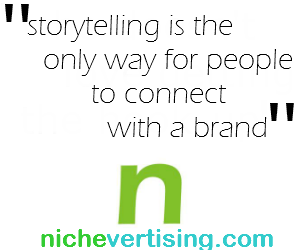 I come from the school of thought that deeply believes storytelling is the only way for people to connect with a brand. As a matter of fact, when an advertisement is put in the form of a interesting or surprising story it becomes less of an ad and more like an experience. In one of my past post I gave you a few quick suggestions to make your emails more viral with storytelling. This time I have a suggestion that may not be as quick and easy for you to implement, but has the potential to pay off big when done right.
I come from the school of thought that deeply believes storytelling is the only way for people to connect with a brand. As a matter of fact, when an advertisement is put in the form of a interesting or surprising story it becomes less of an ad and more like an experience. In one of my past post I gave you a few quick suggestions to make your emails more viral with storytelling. This time I have a suggestion that may not be as quick and easy for you to implement, but has the potential to pay off big when done right.
Yesterday, I came across an article in the Huffington Post written by Derek Smith, Founder, Talk NYC titled “The Impact of Digital Storytelling.” He interviewed the Chief Creative Officer of of Wunderman New York, Nick Moore. Wunderman is an advertising and marketing consulting firm known for using various storytelling techniques in their creative.
Derek Smith uncovered a nice nugget of information that I suggest all bootstrapping entrepreneurs add to their communications toolkit. Towards the end of the article, Smith asked Moore two intriguing question:
What are some non-linear ways brands can innovate in storytelling?
Does multi-channel storytelling work or do you have to adapt individual stories for different platforms?
Moore’s answers, however, weren’t quite earth shattering. Nevertheless, these two questions really got my brain juices flowing. Everyday since I declared that storytelling is one of the 5 critical skills you must learn to create viral advertising, I have been spending 20 to 30 minutes researching the anatomy of a good story told for viral advertising purposes. Although, I am not quite ready to publish my recommendations, I am convinced that nonlinear and multi-channel storytelling are two techniques that will work.
In short, multi-channel storytelling is a technique that a storyteller uses to extend engagement by starting the story on one platform such as in a movie and continue the story on another platform such as a website. For example, a movie could intentionally leave out the back story of its characters and at the same time have a website that goes into excruciating details about the birth and life of everyone who appears in the movie. If the consumer does not engage on both platforms, they will miss out or misunderstand much of the story.
Nonlinear storytelling is a technique that a storyteller uses to manufacture suspense and intrigue by telling the end or middle of the story first, then later concluding with the other parts of the story out of order. A classic example of this is Quentin Tarantino’s famous movie Pulp Fiction.
My suggestion is that entrepreneurs intelligently combine these two techniques every so often to create an interesting and surprising story to carry their brand message in. A great platform to try this on is when you do your podcast or get interviewed for a podcast. 9 times out of 10 people are either listening on their computer or smartphones. This is a great opportunity to tell a nonlinear story with the other parts available only on your website or Facebook page.
Another environment to try this is at networking events. We all have left these events with 10 to 20 business cards, but only remember 1 or 2 of the people who are behind the card. At your next networking event try telling a interesting or surprising nonlinear story and make sure to cut it off before you can conclude. Then leave your business card with a note on the back of it reminding the person to follow-up with you so you can finish the story. Obviously, this will only work if your story really connects with the listener, but it’s sure worth a try since odds are 90% of the people will forget you forever anyway.

There is 1 comment. Add yours.